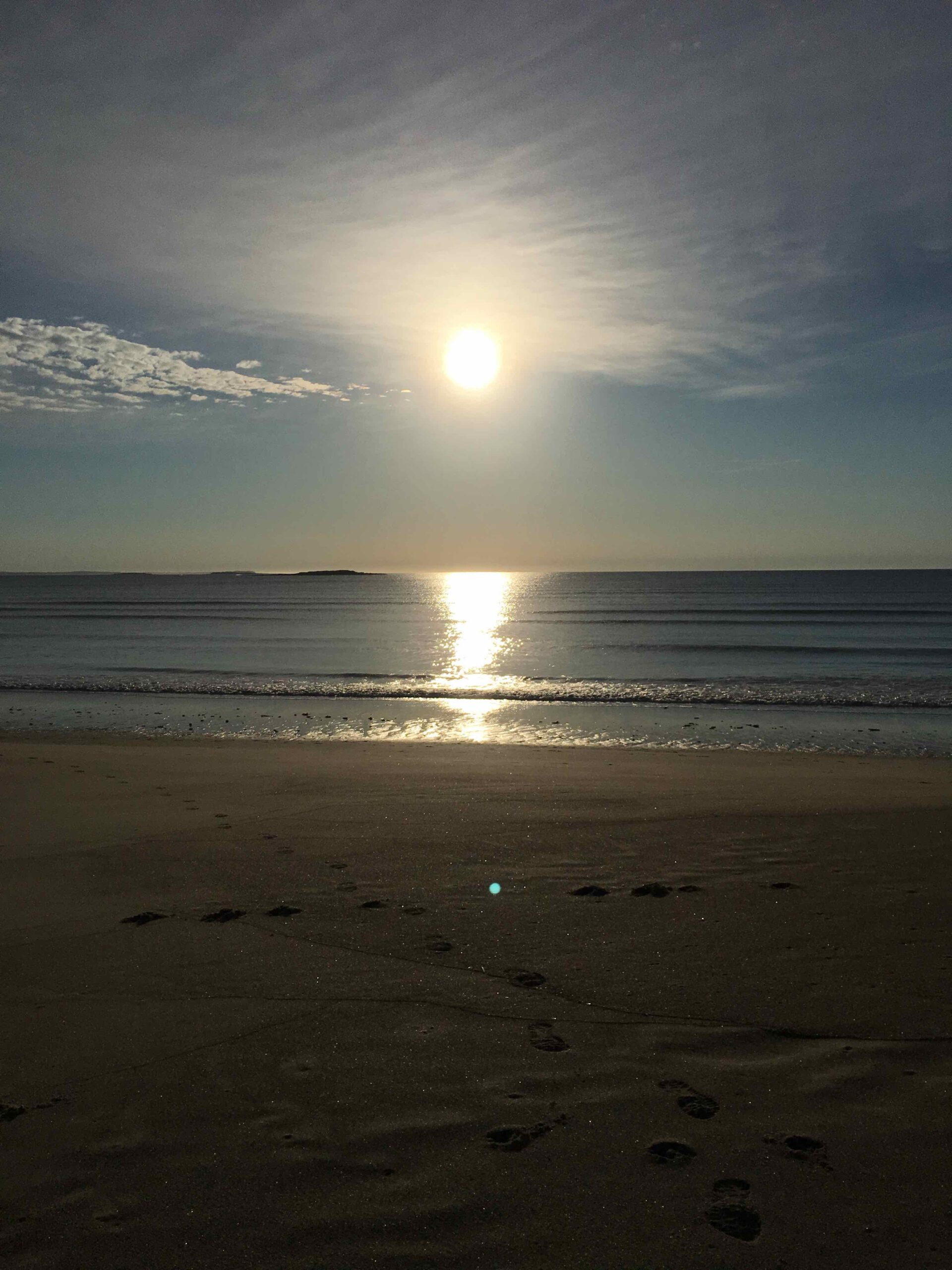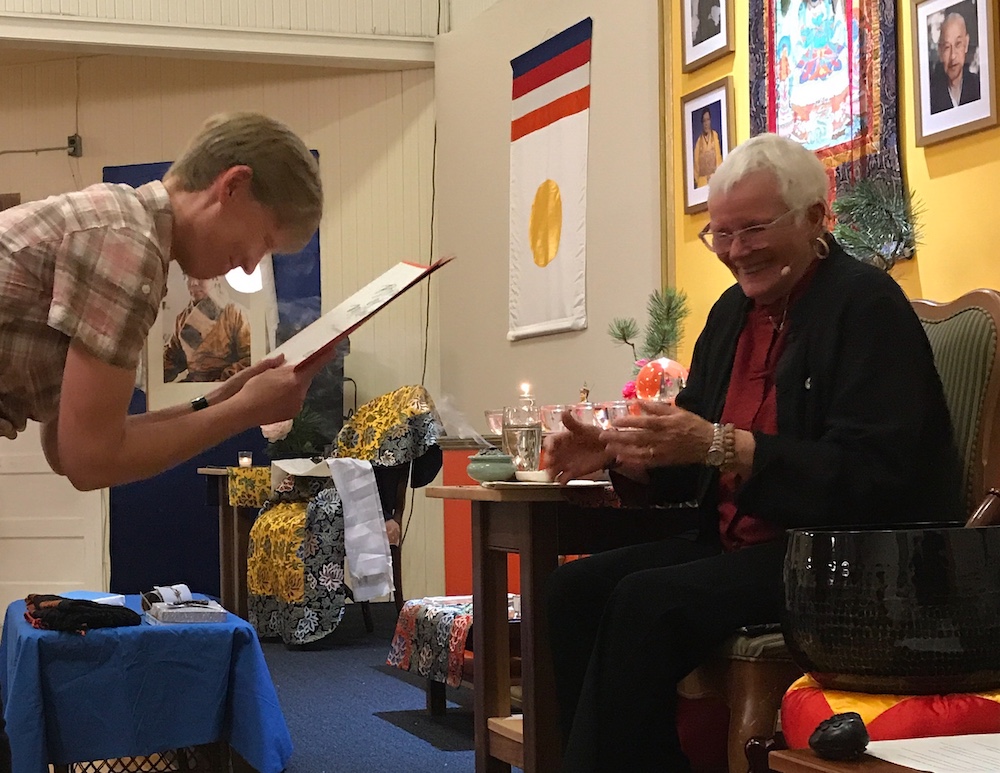
I’ve just got back from a 9 day retreat out in the US at a beautiful conference centre near Maine, New England located right on the Atlantic Ocean. When I say ‘right’, the ocean lapped to the shore just 50m from the meditation hall. An amazing and consistent reminder to awareness to rest and come back to the present moment. I’ve had a wonderful experience, perhaps one of the ‘best’ retreats I have been on – the place, the people, the programme, the teachings, the teacher, the discussions. Even though it is nice to be home, I was truly sad to leave. Perhaps the defining feature was the step I made in taking the Bodhisattva Vow on the final Friday. Whilst something I had been wanting to take for that last 2 years, taking the final decision still felt like a leap: the depth of commitment, the unknown of what that might require and lead to. No wonder the Bodhisattva is considered a warrior.
The retreat is in its 7th year; the brainchild of a community practicing under the Tibetan meditation master Chogyam Trungpa Rinpoche who continue to study his teachings deeply together even after his death back in 1987. The retreats are based on material in the Three volumes of “The Profound Treasury”, a collected works of CTR edited by Judy Lief. Judy, much reknowned for her writing in the Buddhist world, was the teacher at the retreat. I have studied quite a bit with her through online courses, so to be studying and practicing under her directly was the original pull to attend: and I was not disappointed. I appreciated her ‘gentle fierceness’, clearly someone who has a command of the teachings and is able to present them to others in a way that inspires and feels workable.
The retreat theme was “Sharpening the Sword of Prajna”. Prajna is Sanskrit for “best knowing”, but it is not knowing as in knowledge. Rather it is about knowing our experience, to be with things as they are with “curiosity, doubt and inquisitiveness”. As Judy writes about in this article from Lion’s Roar, it is both precise and playful. Prajna helps us truly know our experience, we might therefore equate it with wisdom: the wisdom of a sword that literally “cuts through” the illusions we hold about ourselves, others, our world. How do we develop this wisdom? We sit and meditate; holding our attention to the breath calms the mind so that room for a clear seeing quality develops. Whilst the space that arises can be quite scary (without ‘doing’ we are asked to face our ‘being’), it we can relax in to it our mind becomes more flexible, pliable. The teachings traditionally talk of ‘emptiness’ and its quality of luminosity. Interestingly, it is not only wisdom that is said to arise from this emptiness – as we open and open, we see and feel our world more directly, we feel compassion.
 One might consider compassion as the key to the Bodhisattva path. In taking the vow, I have pledged to help all beings with their pain and suffering. I still need to take care of myself (or I am no good to anyone!) but I am endeavouring to put my personal agenda aside and see any given situation from ALL sides. So often we are bound by our perception as being THE truth.
One might consider compassion as the key to the Bodhisattva path. In taking the vow, I have pledged to help all beings with their pain and suffering. I still need to take care of myself (or I am no good to anyone!) but I am endeavouring to put my personal agenda aside and see any given situation from ALL sides. So often we are bound by our perception as being THE truth.
At the ceremony, we repeat the Vow in the presence of the community of practitioners (the sangha) and we take on the tasks as given by the preceptor. When taking the Refuge Vow (that signifies the moment we first commitment to being a Buddhist) the tasks are the precepts: essentially the promise to not cause harm. For the Bodhisattva, not only are these precepts still held, further tasks, the Paramitas, are to be worked with. The last vow I had taken, my wedding last May, was also based around the Paramitas: so in some ways, the contemplation and practices have already been committed to.
Toward the culmination of the ceremony it is traditional to give a heart gift to the preceptor. As Judy explained, this isn’t a personal gift but rather a gesture of unconditional generosity: working with our attachment to things, people, experiences. I decided to give away one of my rings – a ring with much personal significance, an object that was hard to give away but at the same time felt very appropriate. I had made the decision to part with it only on the morning of the ceremony – the decision was confirmed by finding a heart shape rock on the beach that morning. The rock now sits on my meditation shrine as a reminder of what has been given to me in the act of giving away.

I was also given a new name. At my refuge ceremony, I was conferred the name of Kunsang Sertso (“All good golden lake”). I’ve never been able to relate to the name and inclusion of water (given I cannot swim!), but when I shared my name with my new friends on retreat, they saw the water quality in me: my serenity, my calm, my clarity, and also my depth. I was deeply touched by those assessments given these people hadn’t known me for long.It has taught me that there is much worth in contemplating the name given and go beyond surface perception. Before each Vow, we are required to meet with the preceptor in an individual interview. And from that, Judy is ‘inspired’ and gives a name. It means there is some anticipation and discussion beforehand – what did she see in me, how will she decide who I am, what name describes my Bodhisattva activity? Sometimes the name can be our ‘superpower’,sometimes it can be what we need to work on. This time round, my given name was Gampe Sampa (Bridge of Maitri). Maitri is a quality closely related to compassion – traditionally it is translated as lovingkindness but we can also think of it as love, or as friendliness. At the ceremony, the community greeted this announcement with whoops of joy (one of the reasons I love retreating in the US, the expressions of joy are so exuberant!); Judy and I got the giggles – a moment I will cherish: the significance and the play both existing simultaneously.
Some five days later, I continue to wonder about “Bridge of Maitri” – what did Judy see in me, what is being asked of me that led to this? How will I manifest the ‘bridge’ quality, the ‘friendliness’ quality? I have felt myself in a connector-type role previously in life: bringing together groups of people, and indeed being an educator and group facilitator. I think there is also a “going out” quality – to move beyond my role as a psychotherapist and in to the world. There are already some ideas brewing here (including how my book writing figures), but right now I am resting with this. The transition from retreat back to ‘real’ life is not always straightforward…so right now I am practicing friendliness to myself.

